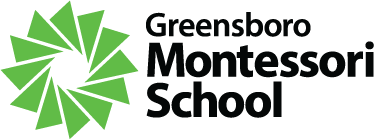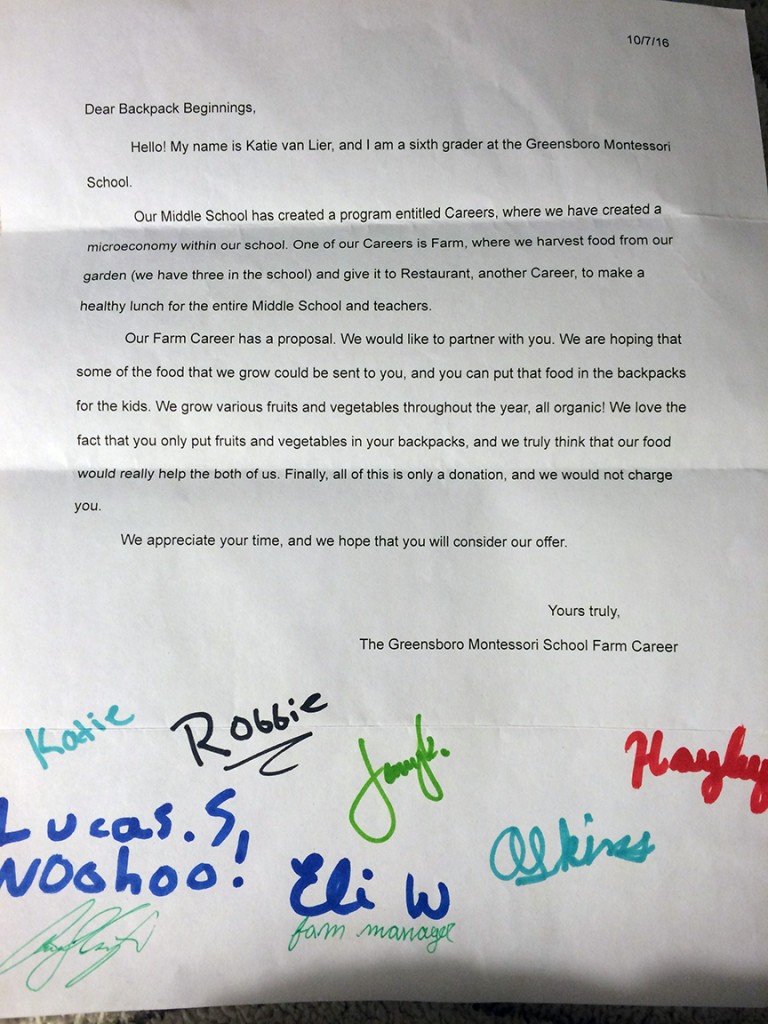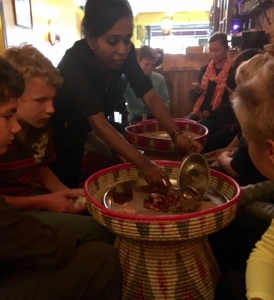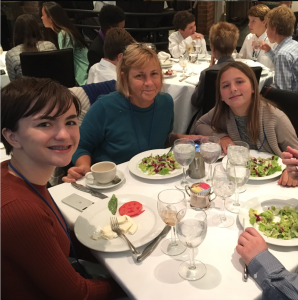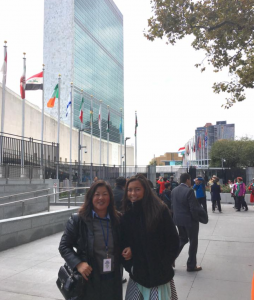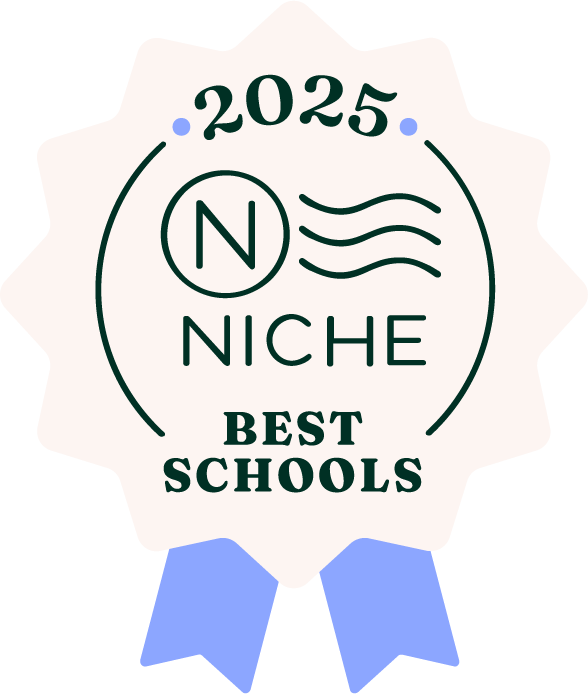Dear Parents, Alumni and Friends,
On behalf of your Search Committee, I wanted to update you on the work we've been doing over the last several months. As we've previously shared, we have been working with Carney Sandoe & Associates (CS&A), a nationally recognized search firm, to help us in our search for the next Head of School.
Over the last four months, our dedicated consultant from CS&A, Marlene Shaw, has identified and reviewed qualifications of more than 30 candidates. The candidates had a wide variety of experiences and skill sets. After much discussion with Marlene, we narrowed the candidate field down to six excellent semi-finalists.
During the first week of January, the Search Committee interviewed each of the six candidates. This was done by teleconference as the candidates are from all over the country. Each candidate possessed skills and attributes that would benefit the entire Greensboro Montessori community.
After lengthly interviews, follow-up phone calls, and multiple discussions, the Search Committee is pleased to announce we have identified our final candidates whom we have invited to visit the School. We will send out information about the candidates via email several days prior to their individual school visits.
After meeting each of the candidates, we encourage you to share your comments through participation in a quick survey. The survey will open the day the candidate visits and remain open for two days after the end of the visit.
In addition to sending our Search Committee updates by email, we are also posting them to this dedicated Head of School Search webpage. Should you have specific questions about the process or thoughts about the candidates, please do not hesitate to contact me.
Best wishes to you and your family!
Sincerely,
David Bouska
Search Committee Chair
Greensboro Montessori School's 12-point Pinwheel is an ideal symbol for the educational philosophy of our School. Designed by an alumni parent, the Pinwheel represents many designs in the natural world. It also portrays the power of the triangle and highlights a simple shape – the scalene right-angle triangle — the School uses to introduce geometry for both work and play.
The scalene, right-angle triangle is part of the Constructive Triangles, materials within Montessori’s “Visual Sense” Sensorial works used to demonstrate how all plane geometric figures can be constructed from triangles. Montessori teachers recognize when children are ready for new discoveries, and they guide their students through direct experiences with simple to complex concepts using the help of didactic materials. The Constructive Triangles epitomize this learning process.
Through manipulating triangles, a very young child gains understanding of the triangle as the first form of reality. In the Rectangular Box of Constructive Triangles, the child finds pairs of matching triangles featuring black lines. One of these pairs is green, scalene, right-angle triangles. When the child joins the triangles along the black lines, she discovers how two triangles create one parallelogram. Later, in the Triangular Box of Constructive Triangles, she revisits the green, scalene, right-angle triangles. This time, the two join to form one equilateral triangle.
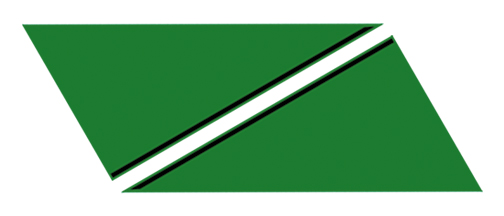
Parallelogram from the Rectangular Box of Constructive Triangles.
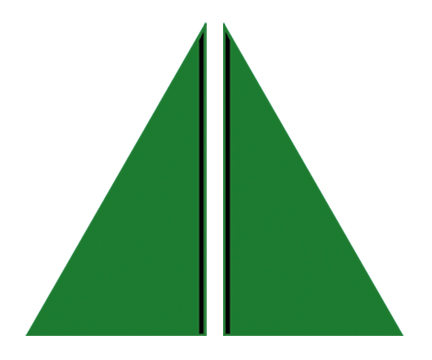
Equilateral Triangle from the Triangular Box of Constructive Triangles.
With the Constructive Blue Triangles, the same young child uses 12 identical blue, scalene, right-angle triangles to create stars; investigate the ideas of equivalency, congruency and similarity; and build more complex shapes. Directing herself in her work, she organically uncovers the power of learning through the simple and playful exploration of triangles.
Just as the scalene, right-angle triangle is the physical and symbolic representation of a powerful learning process hidden within the Constructive Triangles, the Pinwheel is the physical and symbolic representation of Greensboro Montessori School: a transformative community where professional, passionate educators use children’s individual interests, innate senses of curiosity and inherent thirst for knowledge to unlock in them a lifelong love of learning.
Dear Parents, Alumni and Friends,
On behalf of your Head of School Search Committee, I wanted to reach out and share an update on our progress. As you recall, we have been working with Marlene Shaw from Carney, Sandoe & Associates (CS&A). CS&A is a trusted and nationally recognized search firm that specializes in independent schools, and Marlene is our dedicated consultant.
We are wrapping up the end of a three-month "silent period" during which Marlene has guided our team in capturing valuable feedback from our whole community, crafted a customized position description for our Head of School opportunity, and recruited qualified and well-matched candidates for your Search Committee to interview.
Before I continue, I want to again thank you for your active participation in this process. Your feedback from the search survey -- as well as the insights shared with Marlene during her personal discussions with you, our parents, faculty, alumni, students and board members -- were essential in creating the position description. More importantly, your guidance gives Marlene the knowledge necessary to accurately represent our school's strengths, values, culture and hopes for the future.
Marlene is preparing the Search Committee for the next phase of the process, and we will begin the first round of interviews in early January. We are excited by the depth and breadth of applicants who have expressed interest. At this stage in the process, all candidates have been assured complete confidentiality. As we advance to subsequent rounds of interviews, we look forward to sharing more detailed information about our top candidates.
The Search Committee is deeply honored and humbled to be charged with this important work for our School. We are progressing within our projected timeline and working toward having a final decision in early Spring, which will enable our new Head of School to take his or her post in July. We will continue to keep you abreast of our progress through email announcements and this dedicated Head of School Search webpage. Should you have specific questions about the process or recommendations for potential candidates, please do not hesitate to contact me.
Best wishes to you and your family during the holiday season!
Sincerely,
David Bouska
Search Committee Chair
As people learn that Greensboro Montessori School will offer ninth grade beginning in 2017, they ask, “Why are you offering ninth grade? Aren’t your students ready for high school?”
The fact is, our graduates are more than ready for high school. Our middle school program is highly effective at preparing students for a lifetime of achievement, and the qualities of our program look exactly like the middle school described by Dr. William M. Alexander (1912–1996). Alexander, who is widely recognized as the “father” of the American middle school movement, said good middle-level schools (called junior high schools at the time) offered “more of the freedom of movement they need, more appropriate health and physical education, more chances to participate in planning and managing their own activities, more resources for help on their problems of growing up, and more opportunities to explore new interests and to develop new aspirations.”1
Therefore, the question should not be whether Greensboro Montessori School’s middle school is effective. Instead, it should be, “How effective is ninth grade in high school?” Data and educational trends indicate that today’s high school fails to meet the developmental needs of the ninth-grade student.
“Ninth Grade: The Most Important Year in High School” was published on November 1, 2013 on The Atlantic’s website. It’s premise flows from recent research that finds “ninth graders have the lowest grade point average, the most missed classes, the majority of failing grades, and more misbehavior referrals than any other high-school grade level.” The article’s author, Michele Willens, writes, “Not only are youths entering the intimidating institution that is high school, they are experiencing the usual adolescent angst and depending on poor decision-making skills. ‘Students entering high school—just at the time brains are in flux—still have the propensity to be impulsive and are prone to making mistakes,’ says Washington D.C. psychoanalyst Dr. Linda Stern. ‘They are therefore experimental and trying to separate…Put all that together with raging hormones, the normal academic pressures, and meeting a whole new group to be judged by.’”
A blog from Public School Review further explores how the traditional ninth-grade setting impacts adolescents and how “many schools are restructuring their programs so that ninth graders are in a separate setting, apart from the larger high school community.” This trend has taken hold to serve ninth graders’ “distinct needs,” and researchers at Boston College have already determined the effectiveness of the model. “Results from the study show that, overall, the isolation of ninth graders in ‘a separate building, wing or floor eases the transition to high school.’ Paired with this, ‘Ninth grade students benefit by building relationships with peers in the same grade,’ as students, teachers, and [administrators] reported fewer concerns of bullying by older students.”
As Montessorians, when we combine this research with our own knowledge of Dr. Maria Montessori’s four phases of development, we proclaim with certainty that offering ninth grade is the right thing to do for students and their families.
During her groundbreaking studies, Dr. Montessori defined four phases of development in a child’s journey to adulthood: the absorbent mind from zero to six; childhood from six to 12; adolescence from 12 to 18; and the young adult from 18 to 24. Within each phase, Dr. Montessori uncovered two distinct, three-year learning cycles (or subphases) based on sensitive periods of growth and development shared among the age group. The three-year cycle results in multiage classrooms where skills and concepts are introduced, explored and mastered through consecutive years of learning. The three-year cycle also reinforces student leadership through social development.
The adolescent phase of development is unique. Dr. Montessori said, “The third period goes from 12 to 18, and it is a period of so much change as to remind one of the first [period from ages zero to six]. It can again be divided into two subphases: one from 12 to 15, and the other from 15 to 18. There are physical changes also during this period, the body reaching its full maturity."2
The first adolescent subphase from 12 to 15 equates to seventh, eighth and ninth grades. Dr. Montessori would advocate that ninth graders – based on their collective social, emotional, mental and physical development – should be leaders in a multiage grouping with seventh and eighth graders. She would further argue their minds and bodies are better served when positioned as mentors.
Graduates of Greensboro Montessori School thrive in four-year high schools. We count multiple valedictorians, salutatorians and Morehead Scholars among our alumni, and we know some students will continue to graduate in eighth grade and matriculate beautifully into private and public high schools. But Dr. Montessori’s developmental phases and today’s educational research also tell us high school isn’t meeting the needs of ninth graders. As a member of the Greensboro community, leaders in the field of education, and stewards of our students’ education, we have an obligation to offer ninth grade. Not because we think students will have a poor experience elsewhere, but because they will be better served by the ninth-grade experience at Greensboro Montessori School.
1Alexander, William M. “The Junior High School: A Changing View.” Tenth Annual Conference for School Administrators: A National Conference on the Junior High School, July, 1963. Cornell University, Ithaca, NY. Keynote Address.
2Montessori, Maria. The Absorbent Mind. 1949.
With Greensboro Montessori School's tuition payments dedicated to covering Greensboro Montessori School’s operating expenses, grants from the Annual Fund provide the necessary resources to make our School more than excellent - to make us truly exceptional. Through the benevolence of parents, alumni, community partners and friends of the School who give to the Annual Fund, Greensboro Montessori School is able to award grants biannually to teachers and students with specific classroom needs or transformative ideas or both!
Current year grants are funded by the previous year's giving. Contributions generously given and humbly received from last year's Annual Fund have begun taking shape through five grants awarded this fall. They range from simple classroom enhancements for our littlest students to significant technology investments for our elementary programs to supplies for creating a new ecosystem on campus (starring chickens) for our oldest scholars.
- Better Sleep for Growing Toddlers: The Academic-Day Toddler class received three new, high-quality Roman shades with blackout liners to help students get better sleep during nap time. While shades may seem simple to us, anything to promote sleep for our littlest students is transformative. The National Sleep Foundation says, "sleep is especially important for children as it directly impacts mental and physical development...During the deep states of [Non-Rapid Eye Movement] sleep, blood supply to the muscles is increased, energy is restored, tissue growth and repair occur, and important hormones are released for growth and development.
- Reading and Technology Resources for Lower Elementary: With four new Dell Chromebooks and a Raz-Kids subscription, the Lower Elementary program has increased access to age-appropriate, education-based technology. With dedicated laptops in the classroom, students will learn techniques for effective and safe online research and word processing skills. They will also be able to easily practice coding and have seamless access to their Raz-Kids online reading comprehension program. Furthermore, the use of PCs in Lower Elementary prepares students to be "bilingual" in the computer world. In many instances, we as adults use Apple products at home and PCs at work, or vice-versa, so ensuring our student have access to both platforms is important.
- iPads for Elementary Artists: In a continuation of Katherine Gwynn's exploration of the symbiotic relationship between creating with technology and hands-on art making, Greensboro Montessori School's art studio is now home to five iPad Airs and an iPad Pro. Students will integrate drawing, painting, digital photography, digital storytelling, animation and more through these new resources exclusive to our art curriculum.
- Chickens for Middle School Entrepreneurs: After 18 months of planning by students in the R&D (research and development) career track, the Middle School is developing a new ecosystem on campus for chickens. Working closely with Aubrey Cupit, Greensboro Montessori School's garden manager and owner of Gate City Harvest, Middle School students are building a mobile chicken coop, complete with a heat lamp, waterer and feeder for six chickens. Egg production will support the Land Lab, Maria's Café and other microeconomy programs. The coop will also include a technology cart with solar panels to power the coop's heat lamp. The mobile solar panels will also complement science lesson and provide a new power source at the Land.
- Ice for Bumps, Bruises, Food Prep, Entertaining and More: Until recently, we've been stocking our freezer with bags of ice. With a new industrial-grade ice maker, we've traded-out the ongoing cost of purchasing ice with a once-time cost to help us make it on our own (how Montessori of us)! The new ice maker supports the entire student-population ensuring a relatively unlimited supply of ice packs for minor student injuries. This resource will also keep our water and lemonade cold for guests at community events like the Fall Festival, Green & White Bash and End of the Year Pizza Party. Lastly, the Middle School will enjoy easy access to ice for Maria Café and trips to the Land.
Our fall grants are as varied as they are inspiring, but there are two things which bind them all. They are not only the result of giving, but also the reason for giving.
For everyone who has given in the past, is giving today or will give in the future, thank you for supporting Greensboro Montessori School. We are who we are because you have invested in us, and we promise to pay it forward by investing everything we can and all that we have in our students.
We all know about the many benefits of reading books with your child each day. But did you know that children also reap incredible rewards when we put the books aside and tell stories the old-fashioned way, in the ancient oral tradition? Many parents are surprised to learn that even young toddlers can sustain attention for extended periods of time to stories told aloud - without pictures, screens or sound effects. Here are just a few of the benefits of storytelling:
- Builds language skills by enabling toddlers to focus on vocabulary, inflection, dialect, and plot elements without distracting stimuli
- Enhances imagination as children form their own mental images of characters and events
- Builds listening and attention skills, preparing children for longer and more complex lessons as they progress through school
- Develops memory skills, as children retain character names, traits, and events without the assistance of visual aids
- Promotes bonding between the child and the caregiver
We don't have to have an encyclopedic knowledge of folk tales to begin telling stories aloud. Old standbys like The Three Bears, The Gingerbread Man, and Red Riding Hood delight today's toddlers just as they have for generations. We can even share family anecdotes, or stories about things that happened to us as young children. This wonderful article from the National Association for the Education of Young Children has more information and tips for choosing tales to share with your child: Oral Storytelling: Building Community Through Dialogue, Engagement and Problem Solving
In Upper Elementary science classes this trimester, our fourth and fifth level students have completed an in-depth unit on the human brain. They began by studying the different parts of the brain and their specific functions, and then they applied their new knowledge to learn how to strengthen their own brains. These 10 and 11 year olds took their studies one step further and delved into what current brain research teaches us about how we can maximize our own learning.
Students explored the seminal research of Stanford University professor, Dr. Carol Dweck, who coined the term "growth mindset." Dweck's research reveals that student achievement is directly related to a person's beliefs and attitudes about the value of hard work. Our Upper Elementary students learned about the attitudes that comprise a growth mindset and discussed how their own beliefs and attitudes affect their ability to learn.
 As a culminating activity, Upper Elementary hosted a special workshop on the practice of mindfulness as a tool to optimize brain function and reduce stress. The workshop was developed and presented by classmate Raven Enoch and her mother, Dr. Vanessa Abernathy-Enoch. This mother-daughter team shared a multi-media presentation on how the brain and body react to stress and the common sources of stress. They also led the students and faculty in basic mindfulness exercises they can use at home and at school.
As a culminating activity, Upper Elementary hosted a special workshop on the practice of mindfulness as a tool to optimize brain function and reduce stress. The workshop was developed and presented by classmate Raven Enoch and her mother, Dr. Vanessa Abernathy-Enoch. This mother-daughter team shared a multi-media presentation on how the brain and body react to stress and the common sources of stress. They also led the students and faculty in basic mindfulness exercises they can use at home and at school.
To learn more about how to promote mindfulness for yourself and your child, check out this booklist.
To recap their presentation and to demonstrate the importance of parent-child conversations about healthy living, we invited Raven (fifth level student) to interview her mom on the practice and health benefits of mindfulness. See the interview below.
Raven: Mom, what is Mindfulness?
Vanessa: In our workshop, #MindfulnessMatters, we talked about mindfulness as a mental state of awareness and the practices that promote such awareness: a moment-by-moment awareness of our own experience (e.g., thoughts, feelings, bodily sensations and surrounding environment) without judgement.
Raven: How does Mindfulness help with stress?
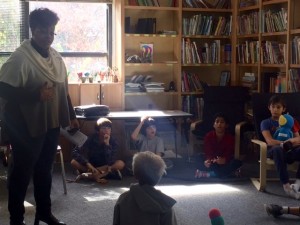 Vanessa: Well, stress is a normal part of life and a necessary part of growing, even in childhood. Stress is simply our AUTOMATIC physical and emotional reaction to life's demands or challenges. Healthy amounts of stress can motivate us to take action. Chronic stress can lead to distress and eventually different types of problems and even illness (e.g., physical, interpersonal and mental). When life's demands exceed our ability to cope with those demands, it can be taxing to our body and mind. Mindfulness practices help to target our automatic and involuntary stress response to prevent or reduce the negative impact of stress and increase coping. Some of our automatic responses to stress include trouble concentrating, inability to relax, muscle tension, and increased heart rate.
Vanessa: Well, stress is a normal part of life and a necessary part of growing, even in childhood. Stress is simply our AUTOMATIC physical and emotional reaction to life's demands or challenges. Healthy amounts of stress can motivate us to take action. Chronic stress can lead to distress and eventually different types of problems and even illness (e.g., physical, interpersonal and mental). When life's demands exceed our ability to cope with those demands, it can be taxing to our body and mind. Mindfulness practices help to target our automatic and involuntary stress response to prevent or reduce the negative impact of stress and increase coping. Some of our automatic responses to stress include trouble concentrating, inability to relax, muscle tension, and increased heart rate.
Raven: Why is it important for kids my age to learn about Mindfulness?
Vanessa: Mindfulness and the practices that promote it can help students improve their abilities in calming their own bodies and minds. The benefits include sustaining attention, improving focus, ignoring distractions, regulating mood and emotions, improving sleep, and increasing readiness to learn. There are many, many benefits that lead to increased thriving and resiliency.
Raven: What are some exercises people can do to help with Mindfulness?
Vanessa: In our workshop we taught students a Deep Breathing exercise (slowly in through the nose and slowly out through the mouth), the 5-4-3-2-1 Relaxation Technique where you focus on your environment using 3 of your 5 senses, and an exercise in Mindful Eating.
[We were also proud to point out that Greensboro Montessori School offers students several opportunities in the course of the day to practice and promote Mindfulness, including exercise, journaling, leisure reading, listening to music, creating art and structured-free time (plus yoga in the primary program)].
Raven: How has practicing Mindfulness helped you personally?
Vanessa: Using Mindfulness practices helps me personally in many ways, including improving my memory, decreasing muscle tension, remaining calm in times of crisis and increasing assertive communication that has improved my relationships, especially with my friends and family. Most of all, it is helping me to do what I hope it will help you and your classmates do: to relate to others and myself with more warmth, acceptance and sensitivity.
Greensboro Montessori School middle school students are excited to be giving back by donating produce harvested from our gardens to BackPack Beginnings. Last Friday marked our first official donation. Students within the Farm Career from the School's microeconomy program harvested two full crates of persimmons, peppers and bags of mixed greens, slated to go to students in need from Jones Elementary.
Several weeks prior, students sent a letter to BackPack Beginnings, extending their support and stating their eagerness to work with them. Then, our eighth grade Farm Manager called Tessa Kirkpatrick, Fresh Food Coordinator at BackPack Beginnings, to arrange a pick up for Friday.
Our relationship with BackPack Beginnings offers a wonderful example of how Greensboro Montessori School's unique middle school programs prepare students to be proactive, mature communicators who are capable of adult interaction. It also illustrates how our students want our school community to experience health and well-being while also helping the Greater Greensboro community to be “full” and nourished. We plan to continue to donate weekly to the BackPack Beginnings Fresh Food Initiative and hope that this is the start of a beautiful partnership.
More about BackPack Beginnings and the Fresh Food Initiative
BackPack Beginnings is a 100% volunteer 501(c)(3) organization focused on delivering child-centric services to feed, comfort and clothe children in need. By ensuring food and basic necessities are given directly to children in need, BackPack Beginnings makes a positive and lasting impact on their health and well-being. The organization was founded six years ago by Parker White, a local mom who wanted to provide hungry children with food over the weekends. BackPack Beginnings has since expanded beyond food back packs and now includes comfort back packs, clothing pantries and food pantries.
BackPack Beginnings' food back packs and pantries are enhanced by the organization's Fresh Food Initiative. Fresh fruits and vegetables improve children’s nutrition, help prevent chronic health issues and curb childhood obesity. More and more research also points to diets rich in fresh foods improving children's ability to learn and their overall school performance.
Led by volunteer Tessa Kirkpatrick (one of our very own Greensboro Montessori School parents), the Fresh Food Initiative focuses solely on making fresh fruits and vegetables available to children in need. Tessa coordinates with multiple agencies, churches, schools and community gardens each week to gather and redistribute fresh food throughout the county. Since July 1, 2016, the Fresh Food Initiative has distributed over 10,000 pounds of produce.
GMS: Tell us how your trip started
Jean-Lou: On Sunday we flew to New York. After we checked in at our hotel, we met some of the students from other schools. There were eight or nine other Montessori schools from different states and also the Dominican Republic. There were over 150 students at the conference.
Isabel: For most of the day on Monday, we heard presentations from many different NGOs [non-governmental organizations] about the work they are doing to help people around the world. Some of the organizations were Save the Rain, Vision For and From Children, Room to Read, and HeForShe.
Click Here to view a brief clip from the NGO presentation forum. Excerpt provided by chaperone, Joan Tao.
Jean-Lou: That day at lunch we went to an Ethiopian restaurant and for dinner we ate at a Moroccan restaurant. Later that night we met up with kids from two of the other schools and had a great time ice skating in Rockefeller Center.
GMS: Was there one aspect of the trip that was your favorite or was the most memorable?
Isabel: I loved being in New York City and everything about this trip. For me, the most memorable part was visiting the 9/11 Memorial and Museum. It is hard to describe the feeling of being there, but it helped me put into perspective all of the people who lost their lives. At the memorial fountain, you can read the names of all of the people who died that day. What I thought was really cool, is that white roses had been placed by the names of people to celebrate their birthdays.
Jean-Lou: I agree that being there was hard to describe. It was just like the quote that we saw on the wall of the museum. I took a picture of it with my camera. “No day shall erase you from the memory of time.”
GMS: Tell us about your tour of the United Nations building.
Jean-Lou: We visited the General Assembly Hall and an art exhibit about clearing land mines. We saw lots of different rooms and sculptures in the United Nations building and each had been contributed by a different country. On Tuesday, we also met with delegates from the Sierra Leone mission. One of the reasons we chose their mission is because our class will be reading the book, A Long Way Gone, later this year. It's a memoir of a boy growing up during the civil war in Sierra Leone.
Isabel: The delegates from Sierra Leone told us about the history of the country and how it was founded by Portuguese explorers who gave the country its name. It means “lions in the mountains." We learned about the civil war that broke out in the 1990s and then how the Ebola epidemic impacted the country a few years ago.
Jean-Lou: Before the Ebola outbreak, they had a rapidly growing economy, but then, all of the international companies withdrew. They made some very strict health rules to help control the spread of the disease. The delegates told us about their country's current president, Ernest Bai Koroma, and how their economy is starting to recover. It was sad to learn that after the Ebola epidemic many of the children were left without parents. But the delegates told us that in Sierra Leone there is a belief that everyone in the village is responsible for raising every child.
GMS: Tell us more about what you learned from the non-governmental organizations
Isabel: Many of the people giving the presentations were college students and that made me realize you don’t have to be an adult to make a difference. Actually, there was a 15 year old girl who told us about the organization called Vision For and From Children.
GMS: Have you thought about which organization you will choose for your follow-up presentation to the community?
Jean-Lou: I hope to do my presentation on the organization Room to Read that was started in Nepal. I was surprised to learn there are schools around the world where the children don’t have any books to read. This organization provides books for schools to help children learn to read in their native language. The organization also works with the governments in those countries to help teachers and also supports the education of young girls.
Isabel: I am planning to do my presentation on HeForShe which builds awareness about the issues of gender equality and specifically getting men and boys involved in the pursuit for gender equality. I also think its cool that Emma Watson [British actor from the Harry Potter movie series] promotes this cause and is the UN Goodwill Ambassador for women.
GMS: How will you stay connected to this experience and share it with you classmates.
Jean-Lou: At the end of the conference we voted to decide which organization we would work together to support. We chose Save the Rain which builds water catchment systems for villages that don’t have clean drinking water. To start, we are planning to use the money we raise through the Middle School Rock-a-thon and the proceeds from the lunch we serve at the Greensboro Montessori School International Fair to donate to Save the Rain.
In this GMSCA interview, we invite you to meet Sophia Dubrovsky, Alex Trestman and their sons, Luka and Ethan, ages four and two, respectively. This interview was conducted by Amy Blanton, GMSCA Communication Coordinator, and fellow Montessori mom.
We were excited to recently catch up with Sophia and her family to learn more about them! It was such a pleasure to interview Sophia as she is a beacon of kindness, warmth and light. You may recognize Sophia from the GMSCA Events Team. Last year she led the effort to organize our school's International Fair which is an annual event held in late January.
GMSCA: Hi, Sophia! Thank you for being our first GMSCA feature family for 2016. We are so excited to chat with you! Tell us about a bit about your family!
Sophia: We moved here from Connecticut and remain in Greensboro mostly due to the community we've found at Greensboro Montessori School. Alex works for Honda Jet, and I have my own consulting company called Plant Based Made Easy. Luka started at Greensboro Montessori when he was 18 months old and is now in his second year of Primary in Isabelle and Gail’s classroom, and Ethan just started his first year in Toddler with Skye and Marie.
GMSCA: How did you end up at Greensboro Montessori School?
Sophia: We toured the School when Luka was just 14 months old. I immediately felt at home, especially in the gardens. I knew instantly that this is where I wanted my kids to spend their days. I love the exposure to the outdoors, and the opportunity they have to develop into their own people. It is a very lovely, cozy environment that I felt would allow Luka (and later Ethan) the freedom to explore. Greensboro Montessori is not a cookie cutter program; it gives children the opportunity to mature into their own interests. That was important to our family!
GMSCA: Tell us about your involvement in the GMSCA.
Sophia: Being part of the GMSCA has been wonderful! All of our family and friends live in Connecticut. It wasn’t until joining the GMSCA that I felt like I had found my tribe. We love how community-focused the School is, and it has given us a reason to grow roots in Greensboro. Volunteering is a great way to meet other families. You can volunteer as much or as little as you want. I’ve loved being a room parent for Luka's and Ethan’s classrooms; it’s a great way to be involved with the life of the school and support the teachers. Last year I was the chair of the International Fair and it was an incredible experience reaching out and learning about all the different cultures represented at our School. If anyone is looking for a way to get involved with the community, show up to our next monthly GMSCA meeting.
GMSCA: We can’t wait to see what is in store for this year’s International Fair in January! Tell us more about your sons, Luka and Ethan.
Sophia: Luka and Ethan are both adventurous and charismatic boys, and Greensboro Montessori has been instrumental in Luka’s growth over the last four years. I love that he has a place to explore without the pressure of workbooks or homework. Ethan just enrolled this fall and the toddler program is a great outlet for his strong desires for gross motor play.
GMSCA: You mentioned you run your own consulting firm. Please give us a window into your work with Plant Based Made Easy.
Sophia: I am passionate about nutrition and sharing with the community about how easy and monumental a plant-based diet is for your whole family! I offer cooking classes, consultations, and I frequently post reviews and recipes on my blog.
GMSCA: Thank you so much for your time and for sharing about your family, your work and your deep connection to our School!
